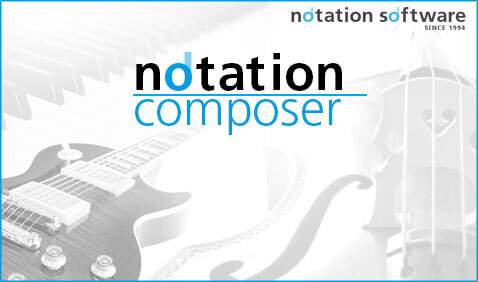Tutorial Videos for Notation Musician and Notation Composer
Get going quickly with notation musician and notation composer, or learn some new tips and tricks if you've been using them a while.
Band-in-a-Box® QuickStart Guide - A brief overview how to use the
Band-in-a-Box® feature in notation composer.
Band-in-a-Box® Tutorial - A full tutorial how to use the Band-in-a-Box® feature in notation composer.
Band-in-a-Box® Product - Product overview of the Band-in-a-Box® feature in notation composer.
Setting up your workspace - A brief look at how you can customize your working space while editing your scores to make your work flow more efficient.
Mac Installation Guide for Version 5 for macOS Sequoia - How to install Notation Software version 5 products on a Mac with macOS Sequoia.
Mac Installation Guide for Version 4, 5 for macOS Sonoma, Ventura, Monterey, Big Sur, Catalina - How to install Notation Software version 4, 5 products on a Mac with macOS Sonoma, Ventura, Monterey, Big Sur, Catalina.
Mac Installation Guide for Version 3 - How to install Notation Software version 3 products on a Mac.
Transcription options - Changing the Transcription Options can help you get exactly the notation that you want from MIDI (.mid) files you find or record.
Lyrics 1- Learn about basic lyric entry using your keyboard.
Lyrics 2 - Learn about copy/pasting from a text editor and entering multiple verses.
Lyrics 3 - Learn about basic font editing (size, style, etc.).
Transpositions - Learn the difference between song key (actual pitches) and instrument key transpositions, and how to do both of these in notation musician and notation composer.
Parts 1 - Learn the differences (and likenesses) between "Part" and "Staff", and how Musician and Composer handle these. You can also create and define a part to include multiple staves for "sections" (eg. horn section).
Parts 2 - Learn how the Parts Wizard can help you quickly prepare Fake Sheets, Chord Charts, and other special parts.
Shifting barlines - Sometimes MIDI (.mid) files that you find may have the barlines incorrectly placed. notation musician and notation composer have the tool for you to fix that issue. (note: If you have a file where the barlines are off, but they are not "off" in a regular way, you may need to use the ReBar tools that are available in notation composer.)
Practicing - Learn about all the tools and the Practice Session features that make learning your music fun and easy.
Formatting the score - While the software formats your scores according to standard engravers rules, you can tweak most items, or specify items to print (or not).
Text and symbols - Learn about the different types of text and symbols, and how to use them effectively.
Note Entry using the mouse and Notes tool palette (notation composer only)
Note Entry with Step-time Recording and Sequential Note Entry (notation composer only)
Note Entry by live recording with a metronome (notation composer only)
Note Entry by live recording for non-keyboard players - MIDI keyboards are the least expensive MIDI instrument option, but what if you don't play keys? This tutorial will show you how easy it is to record and get a good performance and good sheet music even if you don't play keyboard. (notation composer only)
Note editing basics Part 1 - Learn how to use some of the tools in notation composer to edit voices, accidentals, enharmonic spelling, showing/hiding rests, shifting notes for pitch as well as timing and doing other tasks. This topic is broken up into two videos.
Note editing basics Part 2 - the basics continued (notation composer only)
ReBar - Have a file that on opening sounds great but looks unplayable? It was most likely recorded without reference to a metronome. notation composer's unique ReBar feature lets you adjust the barlines, keep the great performance, and get terrific sheet music as well.
Getting a great performance 01 - Learn how to use some of notation composer's specialized tools for ornaments, "piano roll", note velocity and sound changes to give your file a more life-like sound performance.
Virtual MIDI cable installation - There are a lot of great instrument libraries and synthesizers available that will run on your computer, and that can be used as a MIDI device for playing your files in notation musician and notation composer. If you're interested in diving into the world of MIDI device sounds, check out this tutorial video to get started.
Using SynthFont - Learn how to install SynthFont as an inexpensive solution for better sounds and lower latency with notation musician and notation composer.
Getting started with Garritan Libraries - Garritan Sound Libraries offer a reasonably priced alternative for some excellent instrument sounds, and are a popular set of libraries used by many notation composer customers. This video shows you how to use the Aria Player with notation composer. Click on the links to get a zip file of NoteSoft (.not) templates for Garritan Personal Orchestra and Jazz and Big Band that you can use with notation composer.


